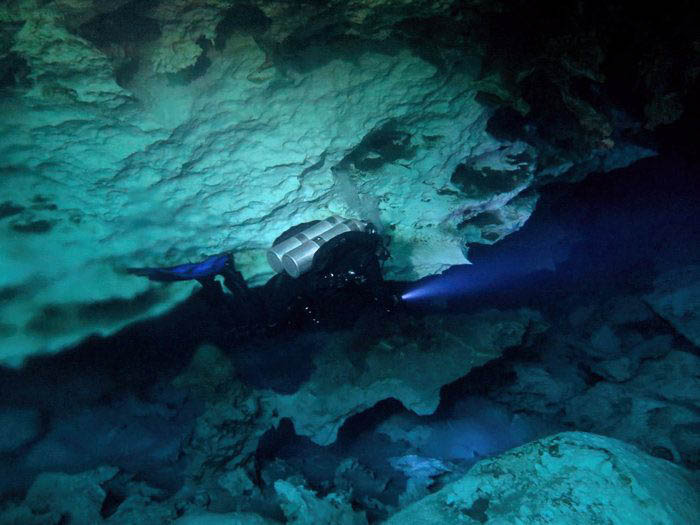Of course this is a very important part of cave diving and is one of the first things learnt during the course.
We use what is called the “Rule of Thirds”. So that is a 1/3 of your available gas to enter into the cave, a 1/3 to come out and a 1/3 as a reserve.
Lets look at a typical example:
A team of 2 divers are planning their dive, both have double aluminium 12 litre tanks with the same pressure 210 bar.
In this case they both have 70 bar to enter, 70 bar to come out and 70 bar in reserve (210bar/3 =70 bar). So when either of the divers reaches 140 bar, they both turn around and begin to exit along the same path they entered.

Each divers starts with 210 bar, they both turn to come back when either of them reaches their turn pressure of 140 bar. On the way back they should only use another 70 bar, therefore finish with 70 bar or more.
Some might say this is being overly conservative, but lets look another scenario:
Same two divers with the same tanks as above. 210 bar each and turn pressure at 140 bar. But this time the dive doesn’t go as well as before.
Diver A loses all his gas due to a burst hose, right at the worse possible moment, which is when Diver B is signalling to turn back as he has reached his turn pressure of 140 bar.

So now they have to share the gas of Diver B, which is 140 bar. They should both make it to the entrance again. It’s important that their breathing rate doesn’t increase. This is why when entering a cave its important to swim in slowly, so you can increase the speed to exit in this situation without increasing gas consumption.
Another scenario is 2 divers with the same size set of tanks but not as full as each others.
Diver A has 210 bar
Diver B only has 180 bar.
In this case Diver A must calculate his turn pressure based on Diver Bs 1/3 (which is 60 bar 180/3=60 bar)
Diver A must turn at 150 bar.(his 210 bar minus Diver Bs 60bar =150 bar)
Diver B must turn when he has 120 bar.

In this scenario the burst hose also happens at the worst possible moment
(funny that eh!!) Diver A has a burst hose just as they were about to turn to come back. All they have now is Diver Bs 120 bar left to get them back to the surface. Again they should be fine as long as they swam in slow and can keep their breathing rate under control.
Scenario 3. What if they didnt calculate their turn pressure based on the fact one diver has less air than the other?
Lets take a look.
Diver A has 210 bar
Diver B has 180 bar
They fail to take into account Diver B only has 180 bar and Diver A THINKS he can turn at 140 bar.

Again Diver A has a hose burst at the deepest point of penertration, right as he has 140 bar. All gas lost. Diver B is also at his turn pressure of 120 bar having used 60 bar on the way in. Diver A needs 70 bar to exit Diver B needs 60 bar to exit making a total of 130 bar needed with only 120 bar available……..
This is one example of why proper cave diving training is important and why progression should take place slowly with experience.
There are other things to take into consideration for more advanced cave dives
involving water flow and dissimilar size tanks. Please get in contact if you would like to discuss any of these subjects.
Here in the Yucatan Penisula we have some of the biggest and best cave systems in the world. Perfect for recreational open water divers to enjoy diving in the cavern areas and fully trained cave divers to venture in beyond the natural light zone.





